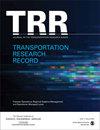Design and Full-Scale Testing of New MASH Test Level 4 (TL-4) Alaska 2-Tube Bridge Rail
IF 1.8
4区 工程技术
Q3 ENGINEERING, CIVIL
引用次数: 0
Abstract
The purpose of this project was to design and test a new Alaska multi-state 2-tube bridge rail meeting the safety-performance evaluation guidelines included in the American Association of State Highway and Transportation Officials (AASHTO) Manual for Assessing Safety Hardware (MASH), Second Edition 2016. The new 2-tube bridge rail designed and tested for this project was crash tested in accordance with MASH Test Level 4 (TL-4). Three crash tests were performed. The new bridge rail is 38 in. tall from the top of asphalt overlay and anchors to a 10 in. high by 18 in. wide curb. The curb was cast on top of a 35 ¾ in. wide deck cantilever that varied in thickness from 6 in. at the extreme field side edge to 12 in. at the exterior girder element. The posts were spaced on 10 ft centers. The posts were anchored to the concrete curb and deck using four 7/8 in. diameter A449 anchor bolts. The two-tube rail elements consisted of two HSS7 × 5 × 3/8 tubular elements. The calculated strength of the design was 77 kip at a height of 30 in. The bridge rail was considered acceptable for strength as per the AASHTO Load and Resistance Factor Design (LRFD) Section 13 Bridge Design Specifications. A test specimen of the bridge rail was constructed and crash tested per MASH TL-4. The new two-tube bridge rail met all the performance requirements of MASH TL-4. Details of the design and testing of the new bridge rail are provided in this paper.新型MASH测试4级(TL-4)阿拉斯加双管桥轨道的设计和全尺寸测试
本项目的目的是设计和测试一种符合美国国家公路与运输官员协会(AASHTO)《安全硬件评估手册》(MASH)2016年第二版中安全性能评估指南的阿拉斯加多州双管桥轨。为本项目设计和测试的新型双管桥轨按照MASH测试等级4(TL-4)进行了碰撞测试。进行了三次碰撞试验。新的桥轨是38 从沥青覆盖层和锚固件顶部到10 英寸高乘以18 宽路缘。路缘石是在35¾ 宽甲板悬臂,厚度从6 在极端场侧边缘处为12 在外部梁元件处。柱子的间距为10 ft中心。使用四个7/8将立柱固定在混凝土路缘石和甲板上 直径为A449的地脚螺栓。两个管轨元件由两个HSS7组成 × 5. × 3/8管状元件。设计的计算强度为77 在30米高处跳跃 根据AASHTO荷载和阻力系数设计(LRFD)第13节《桥梁设计规范》,桥轨的强度被认为是可接受的。根据MASH TL-4建造了桥梁钢轨的试样并进行了碰撞试验。新型双管桥轨满足MASH TL-4的所有性能要求。本文详细介绍了新型桥梁钢轨的设计和试验情况。
本文章由计算机程序翻译,如有差异,请以英文原文为准。
求助全文
约1分钟内获得全文
求助全文
来源期刊

Transportation Research Record
工程技术-工程:土木
CiteScore
3.20
自引率
11.80%
发文量
918
审稿时长
4.2 months
期刊介绍:
Transportation Research Record: Journal of the Transportation Research Board is one of the most cited and prolific transportation journals in the world, offering unparalleled depth and breadth in the coverage of transportation-related topics. The TRR publishes approximately 70 issues annually of outstanding, peer-reviewed papers presenting research findings in policy, planning, administration, economics and financing, operations, construction, design, maintenance, safety, and more, for all modes of transportation. This site provides electronic access to a full compilation of papers since the 1996 series.
 求助内容:
求助内容: 应助结果提醒方式:
应助结果提醒方式:


